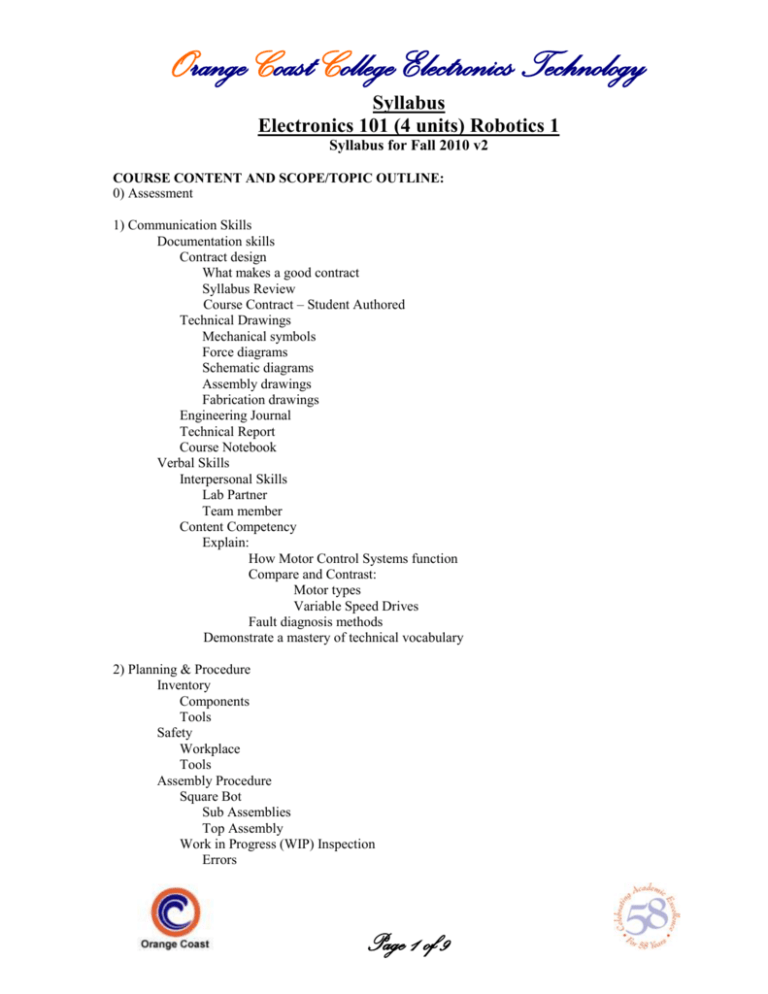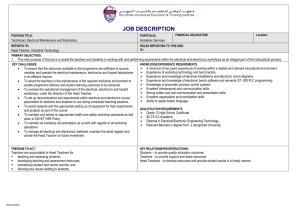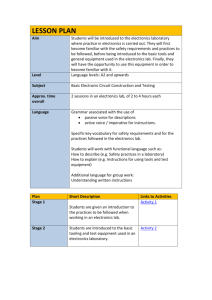Spring 2012 - A101 - Robotics 1 Mech Design Part 1
advertisement

Orange Coast College Electronics Technology Syllabus Electronics 101 (4 units) Robotics 1 Syllabus for Fall 2010 v2 COURSE CONTENT AND SCOPE/TOPIC OUTLINE: 0) Assessment 1) Communication Skills Documentation skills Contract design What makes a good contract Syllabus Review Course Contract – Student Authored Technical Drawings Mechanical symbols Force diagrams Schematic diagrams Assembly drawings Fabrication drawings Engineering Journal Technical Report Course Notebook Verbal Skills Interpersonal Skills Lab Partner Team member Content Competency Explain: How Motor Control Systems function Compare and Contrast: Motor types Variable Speed Drives Fault diagnosis methods Demonstrate a mastery of technical vocabulary 2) Planning & Procedure Inventory Components Tools Safety Workplace Tools Assembly Procedure Square Bot Sub Assemblies Top Assembly Work in Progress (WIP) Inspection Errors Page 1 of 9 Orange Coast College Electronics Technology COURSE CONTENT AND SCOPE/TOPIC OUTLINE continued: Assembly Technique – Following Instructions Instructions Modifications Improve Design Efficiency Reliability Serviceability Add Function & Capability Push Pull Lift - Arm Grab – Hand Quality Assurance Documentation System Test 3) Test Transmitter Receiver Embedded Programs Quality Assurance WIP Inspection System Test Functional Test Calibration & Alignment Friction Forces Maneuverability Standards & Units Scalars Time Length Mass Temperature Speed Weight Force Work Power Energy STP 4) Static’s Fasteners Brackets Structures Beams and Braces Page 2 of 9 Orange Coast College Electronics Technology COURSE CONTENT AND SCOPE/TOPIC OUTLINE continued: Levers Vectors Moment of Arm - Torque - Arc Length Trusses Tension Compression Friction Co-efficient of Static Friction Normal Force Physics 1. 2. 3. 4. 5. Units, physics quantities, vectors Motion in a one and two dimensions Newton's laws, equilibrium of a particle, and gravitation Work and energy Torque, equilibrium of a rigid body, and rotational, Arc Length 5) Dynamics Thermodynamics Simple Machines Wedge Screw = Arc Length = moment arm Gears Ratios Types Sprocket Bevel Cam Screw Drive Rack & Pinion Pulleys Torque vs. Speed Thermodynamics RPM Angular Velocity Radius = Lever Arm = Moment Arm Wheels Bogies Arc Length Top Speed vs. Torque Thermodynamics Energy Power Page 3 of 9 Orange Coast College Electronics Technology COURSE CONTENT AND SCOPE/TOPIC OUTLINE continued: 6) Powertrains Motors Permanent Magnet Servos Batteries Alkaline Re-chargeable Ni-Cad Testing 7) Imagineering Scientific Method Design Criteria Imagination Simplicity Dual function Efficiency Weight vs. Power Ratio Critical Thinking Creativity Re-Vision What if? Resources Time Manpower Faculties Budget Engineering Review I Specifications Tournament Rules Engineering Review II Quality Assurance Test Diagnostics Documentation Judging Criteria Page 4 of 9 Orange Coast College Electronics Technology STUDENT LEARNING OUTCOMES: The student will be able to: 1. Invent robotic solutions according for specified engineering problems associated with mechanical design. 2. Design a robot to compete according to tournament rules. 3. Diagnose and discuss their invention and modify it to improve original design. 4. Apply cooperative skills to the work place. 5. Demonstrate an understanding of the function of mechanics in robotics design. INSTRUCTIONAL OBJECTIVES: The student will be able to: I Communication Skills 1. Produce documentation commonly found in industry including but not limited to: engineering journal, technical report, wiring diagrams, schematics, assembly diagrams, data charts, data tables, Bill of Materials, procedures, etc. 2. Explain to and/or instruct others how to: operate, calibrate, the robot they have built. 3. Explain the application of physical laws employed in the structural design. 4. Explain the application of physical laws employed in the system design. II) Planning & Procedure 1. Create a Bill Of Materials for their design project and maintain an inventory control system for equipment and materials 2. Inculcate the value of safety first in the workplace. 3. Develop a plan for project success that includes “Work In Progress” review to verify the design meets specifications. 4. Adjust the plan and improve the design to meet: specifications, scheduled time lines, and improve efficiency. 5. Improve the design by adding function and value to the original design. Test Test separately and collectively the integrated technologies that comprise the system design, including but not limited to: electrical, electronic, mechanical, standards, and documentation. Static’s 1. Analyze, and diagnose mechanical structures 2. Explain and demonstrate an ability to apply Physics Mechanical Laws and theories in structural and chassis design. Dynamics 1. Analyze, and diagnose simple machines 2. Explain and demonstrate an ability to apply Physics Mechanical Laws of: thermodynamics, torque, wheels and gears in the design of robotic transport and workload systems. Page 5 of 9 Orange Coast College Electronics Technology INSTRUCTIONAL OBJECTIVES continued: Powertrains 1. Select, construct and evaluate motors and actuators for efficient and effective design to meet specifications. 2. Select, construct and evaluate electrical power systems including: battery types, chargers, charging methods, series, parallel and combination battery systems. Imagineering 1. Invent a robot to engage in tournament competition. 2. Inculcate the scientific method in the design process. 3. Verify the design meets criteria established by tournament rules of engagement. 4. Discuss and defend the robot design with regard to: abilities, restrictions and, compromises. METHOD OF STUDENT EVALUATION: Documentation: Engineering Daily Journal Notebook/Portfolio: Syllabus Contract Project Reports Tests Class Assignments Written, verbal, and practical tests. Engineering Review of student design Participation in a robotics tournament, and/or other service learning events where real-time troubleshooting is required. INSTRUCTIONAL METHODOLOGIES: This course is taught using project based learning methods that actively engage in the student in the learning process. Students will work cooperatively to produce assigned projects according to specifications established by faculty and “Third Party” sources. Inquiry based lectures and discussions prepare students to understand and apply theoretical concepts. Rules of engagement for various tournaments provide specifications for design criteria and evaluation. The following methods are employed during the course. Lecture and application of ideas Demonstration of various approaches to problem solving Discussion Individual, paired, and small group exercises Instructor feedback Peer feedback Slide-lectures to illustrate concepts Video-lectures Collaborative learning Event debriefing discussions Page 6 of 9 Orange Coast College Electronics Technology Field trips to service learning events and industry sites Interactive computer use Graphing calculators Site visits WRITING ASSIGNMENTS/PROFICIENCY DEMONSTRATION: Documentation: Engineering Journal, notebook, project reports, Assorted research sources on and offline Page 7 of 9 Orange Coast College Electronics Technology Syllabus Continued Specifications Deliverables The student will deliver the following components in a portfolio: Student Contract (Mandatory Requirement) o This Syllabus o Spreadsheet Of Deliverables Journal (Mandatory Requirement) Original Class Notes Lecture Lab Selected Chapter problems Attendance Record The student will document their individual effort in the form of a weekly progress report, the report will show billable hours. Total accumulated hours should match the modified Carnegie Unit formulae below. Total Hours/Class/Week = 3.3 * Units/Class = 3.3 * 3 = 9.9 H/C/W 12 projects w/ Proficiency Assessment Scores for each project (Mandatory) 4 (Four) Project Reports (2 Mandatory) Use OCC ET approved format for technical reports Record of Work-In-Progress (versions) for each report Quality Assurance signature & date (Final Version) for each project Note “Mandatory Requirements” must be delivered to receive a passing grade. If any of these mandatory components are missing, The client (student) is in violation of this contract and will not receive a passing grade. Page 8 of 9 Orange Coast College Electronics Technology Syllabus Continued Electronics A101 Robotics 1 Specifications All deliverable items are subject to and must pass Quality Assurance Inspection The student will submit the Work-In-Progress (WIP) for inspection by the instructor. This inspection will identify the students mastery of skills and provide specific and focused instruction for those skills that require more development. Frequent re-submittal of WIP ensures the highest quality of work. Student Contract with spread sheet for tracking the students’ progress is mandatory and must be approved by the third week of class. Delivery date per Technical Report no more than 3 days for first draft, no more than 10 consecutive days past project due date. Grade is based on: 1) Required deliverables received 2) Attendance and participation 3) Projects Completed 4) Proficiency Assessments Scores Contact Information Client (Student) Name _______________________________________ Identification Number __________________________ Phone Number ________________________________ Email address _________________________________ Consultant: Professore R. Castaño (714) 432 – 5745 rcastano@occ.cccd.edu Office: Technology Center Bldg 114 Room 225 Lab: Room 226 Office-Lab Hours: M-W-F 2:30-4pm T-Th 11:30-1pm & 2:30- 3pm Notarized receipt: I ______________________ (Print your name here) Have read and understand the requirements listed herein. __________________________ Signature ____________________________ Date Page 9 of 9





